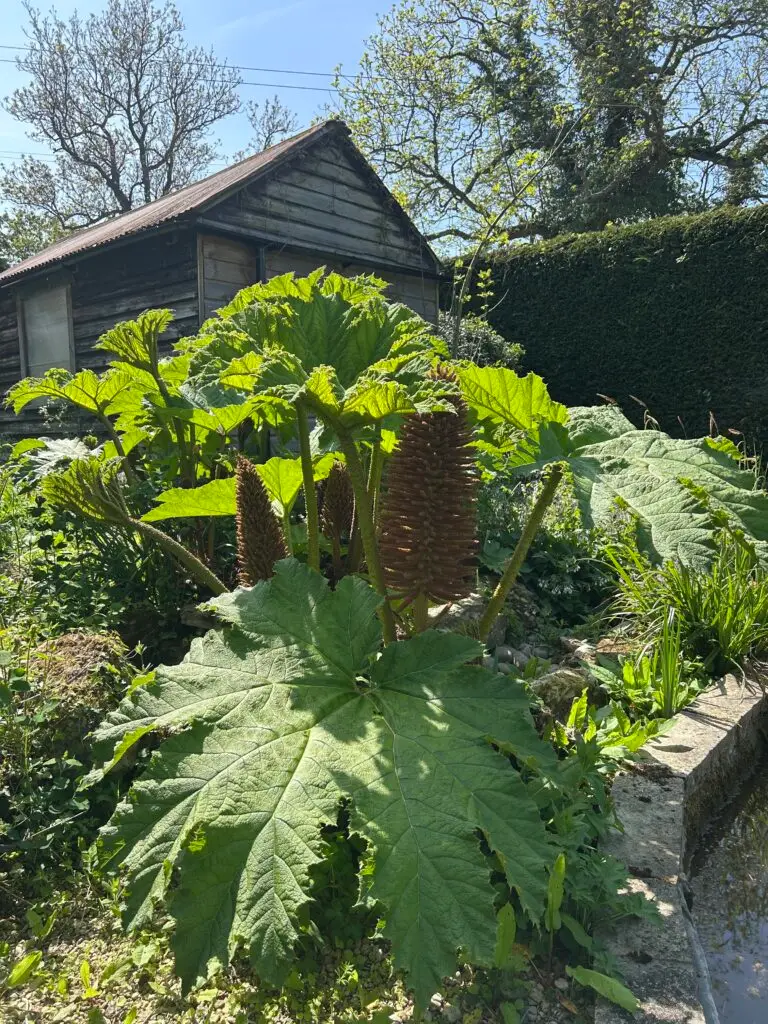Add Your Heading Text Here

Every now and then, a plant arrives in the garden that doesn’t just blend into the background—it takes over the stage. Gunnera manicata is one of those unforgettable characters.
I’ve got one growing in a garden I look after, and each spring it reappears with slow, deliberate force—thick, scaly stalks pushing skyward like something out of the Jurassic era. And then come the leaves: wide, pleated, deeply veined, and impossible to ignore. By midsummer, it’s more than a plant—it’s a landmark.
A Living Sculpture
Gunnera isn’t a polite addition to the border. It’s bold, unapologetic, and theatrical. When well placed, it becomes a centrepiece that adds drama, scale, and even a sense of play. Children and adults alike are drawn to it—there’s something irresistible about standing beneath those vast leaves and looking up as if inside a green cathedral.
But while Gunnera manicata commands attention, it’s not a plant for every garden. You need space. You need moisture. And you need to lean into its wild, almost prehistoric nature.
Where It Thrives
If you’re thinking of making space for Gunnera, here’s what it loves:
USDA Zones: 7–10/ RHS H4 (hardy throughout most of the UK with protection in cold areas)
Light: Full sun to part shade. In hot climates, part shade protects the leaves from scorching.
Soil: Moist, humus-rich, boggy soil is best—ideal near a pond, stream, or damp hollow.
Water: Keep it wet. Gunnera will sulk or collapse if allowed to dry out for long.
Size: Up to 8 feet (2.5 m) tall and wide, often forming a giant clump over time.
It’s not a classic shade plant—but once mature, it creates shade, acting like a giant green parasol for smaller companions.
Planting and Care
This is not a plant to move casually once planted, so choose your spot wisely. Dig in plenty of compost and well-rotted manure to support its hunger for nutrients.
In colder regions, winter protection is essential. The traditional method? Cut and invert its own leaves over the crown in late autumn, then add bracken or straw for insulation. In spring, clear the cover gently—the new shoots emerge quickly once warmth returns.
Companion Planting: Contrast and Texture
Gunnera works best when paired with other moisture-lovers that won’t compete on size but will offer texture and colour. Good companions include:
Astilbes – Soft, feathery plumes in vivid pinks and whites
Ligularia – Golden spires that echo the boldness of Gunnera’s form
Rodgersia – Another large-leaved perennial with refined character
Ferns & Persicaria – For ground-level contrast and movement
Hostas – Shaded and slug-protected, they bring calm to the scene
And if your Gunnera is near a pond, its reflection can double the visual impact—a trick I never tire of.
Final Thoughts: Garden Drama at Its Best
There’s something thrilling about a plant that makes no apologies for its size. Gunnera manicata is garden drama done right—bold, beautiful, and larger than life. Whether it’s the star of a bog garden or a punctuation point by the water’s edge, it earns its keep in spectacle alone.
Have you grown Gunnera? Or seen a showstopper on your garden travels? I’d love to hear about it. Share your thoughts in the comments of this Facebook post.
Happy Gardening.
— Marcus
